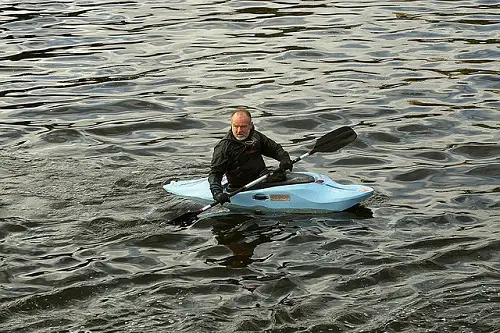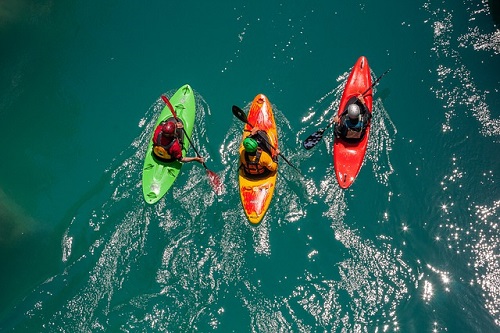There are many types of kayaks for different needs and water conditions. Whitewater kayaks are designed for paddling in rivers with rapids. But what if you want to use one on a lake or any other flat body of water?
You can use a whitewater kayak on a lake, but it will be slower and harder to go in a straight line than with a recreational or touring boat. It can also be tricky to recover from a capsize in open water. Whitewater kayaks are generally small and wide, which isn’t optimal for tracking and speed in flat water.

So I wouldn’t recommend using one on a lake unless it’s occasional or you have no other choice. You can technically use any kayak in any body of water. Your experience will just not be the best if you use a boat in an environment it wasn’t designed for.
With some practice, you should be able to navigate a whitewater kayak relatively comfortably and easily on a lake. After all, most rivers have calm sections. But it will never be as appropriate and performant as a boat made for flat water.
It’s just like a mountain bike. You can use it on the road, but it won’t be as efficient and fast as a road bike. Now let’s keep our focus on kayaks.
What Is The Difference Between A Whitewater Kayak & A Regular Lake Kayak?
Whitewater kayaks are generally smaller, wider, and have a flatter hull than a regular model for better maneuverability in rapids. On the other hand, lake kayaks are typically longer with a rounded or v-shaped hull for better speed and tracking in flat water. So they have different designs for different environments.
In a river, you must be able to perform quick turns and control the boat to avoid obstacles. On a lake, you only need to navigate the water as fast and comfortably as possible in a straight line without flipping over. Now let’s take a closer look at the differences.
Size
A whitewater kayak is typically around 8 feet long and 26” wide but can measure anywhere between 5 and 11 feet in length and from 25 to 28” in width. So it’s relatively short and wide. There are different types of whitewater boats so the dimensions will vary a lot.
On the other hand, the average lake kayak is around 10 feet long and 28” wide at the center, but it gets narrower than a whitewater boat at both tips. Recreational kayaks are generally 6-12 feet long and 26-30” wide while touring kayaks are longer (12-15 feet) and narrower (22”-25”).
How Does Size Affect The Kayaking Performance?
A wider kayak is generally more stable but won’t glide as well and as fast as a narrower boat. For the length, the longer a kayak is, the better tracking and speed. That’s why a long and narrow kayak does better on flat water. So a whitewater boat isn’t ideal for lakes because of its small and large construction.
Hull
The hull is the bottom shape of the kayak. On whitewater boats, they use two types of hulls: planing and displacement hulls. Planing hulls are flat for surfing and spinning, often seen on playboats.
Displacement hulls are generally rounded for better tracking and stability when leaning the kayak on one side for balance and control in rapids. There are also semi-displacement hulls, which are basically a mix of both.
Lake kayaks generally have a flat, v-shaped, rounded, pontoon hull, or a mix of them. Flat and pontoon hulls are more stable and easy to maneuver, while rounded and v-shaped ones go straighter and faster.
So whitewater kayak hulls are more appropriate for navigating and playing in rapids. On the other hand, the bottom of a recreational or touring kayak will perform well in calm and open water.
Cockpit
The kayak’s opening is also a big difference between river and lake kayaks. Whitewater and touring boats will always have a sit-inside cockpit. But a lot of recreational kayaks have a sit-on-top design.
An open cockpit will allow you to protect your legs, store gear, and put on a spray skirt to keep the water from getting in the boat. It also makes rolling possible. A sit-on-top kayak is generally more stable and easy to get in and out of but less performant.
Features
Whitewater kayaks usually have foot and thigh braces, backband adjustments, padding, and grab handles for transport. Recreational and touring models have features such as hatches for storage, bungee cords, and bulkheads to keep the boat afloat if you flip over.
Why Not Use A Whitewater Kayak In Flat Water?
You can use a whitewater kayak on flat water, but you should avoid it as much as possible. It will be slow, not track well, and tire you out much more quickly. So if you’re paddling with other people that have rec and touring kayaks, you will probably struggle to keep up with them.
Don’t Go In Open Water With A Whitewater Kayak!
Another reason you should not use a whitewater kayak on a lake is that if you flip over and can’t roll, you will have to get back on land to relaunch. This type of boat will fill up with water and can be hard to move while swimming. Contrary to recreational and touring kayaks, you can’t self-rescue.
So going in wide open water or too far from the side of a lake might end up in a long swim. Even if you don’t think you will flip over, you never know what can happen. That’s why if you decide to go in on a lake with a whitewater kayak, you should stay close to the land.
When Is It OK To Use A Whitewater Kayak On A Lake?
Sometimes it’s totally fine to use a whitewater kayak on flat water. For example, a lake or calm section of a river is an excellent place for beginners to learn and any paddler to practice. And if it’s occasional or you have no other choice it’s OK to use a whitewater boat elsewhere than in rapids.
What Kayaks Are Best For Lakes?
A recreational kayak is the best option for small lakes and occasional paddlers. It’s very stable and easy to use. Touring kayaks are more appropriate for open water and long paddling trips because they track better, go faster, and have more storage room. Then, a fishing kayak is ideal for anglers to catch fish on a lake.
So What Kayak Should You Get?
You should mainly choose your kayak depending on where you plan to paddle. If you want to go down rivers and rapids most of the time, you should get a whitewater boat. But people that will kayak in lakes more often should probably opt for a rec, touring, or fishing boat.
Crossover Kayaks For Whitewater & Flat Water
If you plan to paddle equally in rapids and lakes, you probably want something that will perform well in both. That’s where crossovers come into play. They are versatile kayaks made to navigate whitewater as well as flatwater. So it could be an excellent option for paddling in different environments with the same boat, but you will sacrifice performance.
Can You Take A Whitewater Kayak In The Ocean?
You can take a whitewater kayak in the ocean, but it is not recommended. It will be hard or maybe impossible to pass the surf zone, and you won’t be able to self-rescue in open water. So you will have to swim back to the shore if you capsize. Whitewater kayaks are not well-suited for the ocean.
I tried it once with my dad, and it didn’t work at all. We wanted to surf in the ocean with our whitewater playboats, but we couldn’t get very far because the waves kept pushing us back to the coast. That’s why I wouldn’t recommend it unless you have a long boat or the water is really calm.
Can You Use An Ocean Kayak In A Lake or River?
You can use a sea kayak in a lake or river, but it won’t be very stable and will be hard to maneuver. An ocean kayak can do well in open water. So it would be fine on a large lake or a slow river. But you should not use one in rapids or a very small body of water.
Last Thoughts About Using A Whitewater Kayak On Flat Water!
Finally, you can use a whitewater kayak on a lake, but it will be slow, hard to paddle in a straight line, and won’t be as efficient on flat water as in rapids. So you might have difficulty keeping up with recreational and touring kayaks while getting tired more quickly.
Yet it’s better than nothing, and you should get used to it. After some practice, navigating a whitewater boat in flat water can be relatively easy and comfortable. I do it in calm sections of a river, so why not on a lake?

But if you plan to do mostly flatwater kayaking, you should consider investing in a boat designed for that environment. Then, people that want to do both equally can get a crossover. And if you will mainly go down rapids, a whitewater kayak is what you need. You’re new to this paddling sport? Here’s how to get into whitewater kayaking!
Let’s Have Fun On The Water!
